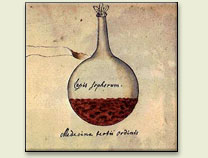The stone of the wise.The medicine of the third order. A month having been completed, the omnipotent king or our stone arises, the perfect medicine of the third order in its projection able to transmute all metals.
(Source: Cabala mineralis manuscript, at Alchemy Web Site.)
According to the ideas of Alchemy the whole matter was endowed with life. Dyeing was an animated process utilizing powers innate to matter. Roger Bacon, learned monk and scientist, wrote in 13th century:
"Alchemy is of great practical use; it teaches us to prepare precious metalls, dyes and many other usefull things in a better and richer way than they are brought forth in the Nature." (Bruns 1997, p. 70)
Red was the alchemical color of all colors. Preaparation of Vermilion (mercuric sulfide) from mercury and sulphur was worked out in all details. Vermilion and mercury itself were considered by some adepts to be the preliminary stage to the "Philosophers Stone" - a magic substance which was capable of converting cheap metalls into gold. Owners of this stone were thought to have magical capabilities. The search for the Philosopher Stone could be construed to be the symbol of the quest for higher states of life (see Paulo Coellho: The Alchemist). There were many complicated and even magical steps to the preparation of this imaginary substance. The completion of this Opus Magnus (Great Work) was signalled by reddening of the mixture ("rubedo"). This being the reason for naming the Philosopher Stone "Red Lion" or "Great Red Water". (For a detailed account of this subject see: Alchemy and Colour, CIBA Review 1961/5, p. 2-33)
(main yellows page) - vermilion - red lead - Madder lake (alizarine) - realgar - Red ochre

